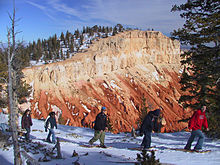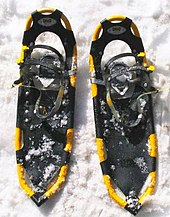Snowshoe
Snowshoes are an aid to getting around in snow conditions that have long been common in many snowy areas. They distribute the weight of the person who is carrying them over a larger area so that the feet are less likely to sink into the snow. Today, snowshoeing has become a popular winter sport as an alternative to touring skiing .
Bog shoe
Similar or identical shoes are used for the same reasons for hiking in bogs , e.g. B. in the Baltic States, used.
history
The origin and age of the snowshoes are unknown. The Greek historian and philosopher Strabo (approx. 63 BC - approx. 24 BC) wrote that the inhabitants of the Caucasus region used flat leather surfaces in order not to sink into the snow, and that Armenians used round wooden surfaces for this . What is certain is that people in snowy areas used snowshoes a very long time ago.
Almost every indigenous tribe in America invented their own type of snowshoe, the simplest and most primitive were invented in the far north. The Eskimos have two different types: one type is triangular in shape and about 45 cm long, the other type is round. Further south the snowshoes get narrower and longer; the longest snowshoes are found among the Cree Indian people , they are almost two meters long. The normal snowshoe is similar to a tennis racket .
At the Gurgler Eisjoch ( 3151 m above sea level ), the transition from the South Tyrolean Pfossental to the Gurgler Ferner in the Ötztal Alps , the glacier released a snowshoe in 2003 which, as far as we know, seems to be older than Ötzi . The snowshoe was found during surveying work by the Italian military by the cartographer Simone Bartolini and handed over to the South Tyrolean Archaeological Museum in Bolzano in July 2015 . The snowshoe consists of an approx. 1.5 m long birch branch , which was bent into a round-oval frame with a diameter of 32 cm. Several strands are stretched inside. According to a report from the State of South Tyrol, radiocarbon dating has shown that the shoe dates from the late Neolithic , i.e. between 3800 and 3700 BC.
Snowshoes were very slowly adopted by Europeans in America. Snowshoes worn by loggers are about three feet long and relatively wide, while trackers' shoes are over five feet long and very narrow. This shape was adopted by Canadian snowshoe clubs, but shortened to about one meter and widened to 40–45 cm. These snowshoes were pointed upwards at the front and had a kind of tail at the back. This construction makes the shoes particularly light for running, but more difficult for hunting or hiking. The "tail" keeps the shoe straight when walking.
Traditional snowshoes are made from a single strip of hardwood (usually white ash ) that is bent into an oval ring, attached at the ends, and stabilized by a cross bar in the middle. The space in the frame created in this way is filled with a dense network of strips of leather from reindeer or cattle . Directly behind the cross brace, only a small opening is left open for the toe of the moccasin- clad foot. The snowshoes are usually attached to the moccasin with leather straps, less often with buckles . Such shoes are still made and sold by Native Americans.
Snowshoe and ski
Skis , too , used to be called “snowshoes”. For example in Fridtjof Nansen's book Auf Schneeschuhe durch Grönland (translated from Norwegian in 1891) or in Arnold Fanck's film The White Rush - New Wonders of the Snowshoe (1931).
World championships
World snowshoeing championships have been held annually since 2006 by the World Snowshoe Federation .
| Men | Women | |||||||||||||||||||||||||||||||||||||||||||||||||||||||||||||||||||||||||
|---|---|---|---|---|---|---|---|---|---|---|---|---|---|---|---|---|---|---|---|---|---|---|---|---|---|---|---|---|---|---|---|---|---|---|---|---|---|---|---|---|---|---|---|---|---|---|---|---|---|---|---|---|---|---|---|---|---|---|---|---|---|---|---|---|---|---|---|---|---|---|---|---|---|---|
|
|
Hikes with snowshoes

Nowadays the snowshoe is viewed more as a piece of sports equipment. Running and hiking with snowshoes has become a trend sport since the mid-1990s . It is primarily suitable for people who do not want to or cannot ski and for whom fast descents are not important. Most of the Alpine peaks that can be climbed on skis in winter can also be reached with snowshoes. In the French Alps, snowshoeing has been a popular sport for years. Tourist locations and restaurants have set up accordingly, many mountain guides, Alpine Club sections and commercial tour operators offer guided tours and advise on equipment issues. As part of SwitzerlandMobility , the snowshoe routes were uniformly marked. There are also special guides for snowshoeing.
Benefits of snowshoeing
- Snowshoeing can be practiced in the full range, from leisure to high-performance sport - depending on the running speed and terrain
- The technique of snowshoeing requires almost no previous knowledge
- Snowshoeing is a complement to cross-country skiing, as it is also an endurance sport and is also suitable for steeper terrain where there are no trails.
- Snowshoeing can be done with any snow thickness and type; From powder snow to crusty snow, many types of snow can be walked on. This means that you are less dependent on external conditions, and the winter sports areas can dispense with the effort required to prepare slopes in alpine skiing.
- Snowshoeing is a supplement to other winter sports and only requires a small investment, as the remaining accessories such as telescopic sticks, hiking boots, etc. are often already available.
- As Nordic snowshoeing, snowshoeing is becoming more and more popular with Nordic walkers, who can therefore do their training all year round.
Preparation of a tour
Similar to ski tours, off-piste and cross-country trails, hikers should always pay attention to nature conservation, avoid forest areas, adhere to the prohibition of entry and be able to decide when a tour has to be interrupted in good time (e.g. if there is a risk of avalanches, exhaustion, Orientation problems with poor visibility or time lag). To minimize dangers as much as possible, all snowshoe hikes must be carefully prepared. This particularly includes:
- Get information about avalanche levels and weather, then organize the tour
- correctly assess the performance of the participants
- Determine the optimal, ie safest, route by carefully studying the map
- Calculate the time required for breaks, refreshments and reserves (in winter the days are short), a more difficult descent then takes longer than the ascent
- Control of avalanche and emergency equipment
equipment

For a snowshoe hike, in addition to the snowshoes themselves and two ski sticks with a large snow basket, a number of other items of equipment are recommended. This includes:
- Backpack with a fastening device for snowshoes
- Mountaineering shoes and gaiters
- Food and hot drinks, sleeping mat or seat cushion as a base
- Weatherproof winter clothing (breathable)
- An avalanche equipment consisting of an avalanche transceiver , a shovel and an avalanche probe . Optionally, an airbag backpack , an avalanche ball and an avalung can also be carried.
- Emergency equipment consists of a first aid kit, a cell phone for making emergency calls, a rescue blanket and a bivouac sack for a possible emergency bivouac or to keep an injured person warm.
- Headlamp for tours at night or at dusk .
Types of snowshoes
Especially with their use in winter sports, the snowshoes have been further developed over time and designed for special areas of use. Today snowshoes are commonly divided into three types. When choosing snowshoes, the intended use, the nature of the snow (powder snow, hard snow) and body weight must be taken into account.
"Originals"
The original snowshoe of the Trapper consists of a curved piece of wood tied together at the back, which is covered in a mesh with resin-coated leather. Due to their extremely large stepping area, they are particularly suitable for flat and deeply snow-covered areas.
"Classics"
Similar in shape to the originals , but consisting of an aluminum frame and covered with a plastic skin. This type of snowshoe is robust and, depending on its size, can mainly be used in easy terrain and deep snow. They provide little support when crossing steeper slopes, such as those found in high alpine terrain, because the aluminum frame with the plastic skin offers too much gliding surface.
"Moderns"
These modern snowshoes are adapted to alpine snow and terrain conditions and are mostly made entirely of hard plastic, are cold-resistant down to −40 ° C and mostly smaller and more agile than the originals or Classics . They are characterized by a smaller footprint and are equipped with pointed steel pins, crampon-like side rails and sharp crampon - like front spikes that are rotatably mounted on the binding . This makes them suitable for high-alpine tours with steeply sloping crossings or hard firn. Thanks to special frame shapes, it is also possible to cross steeper slopes.
For the common snowshoes, no special binding shoes are necessary as for skiing, the strap bindings are suitable for all snow-compatible hiking boots.
It is important that the contact surface of the snowshoes corresponds to the total weight of the runner (body plus backpack) and the snow conditions . Excessive, energy-consuming sinking in can be avoided with the expensive models with snowshoe extensions of different lengths. Otherwise there are different snowshoe sizes depending on body weight.
equipment
- Climbing aid for ascents: A bracket that can be folded under the heel (like a high shoe heel) so that the foot is approximately level on the snowshoe, even when walking uphill. A power saving of up to 30% is noticeable. The folding and unfolding is mostly done with the help of the touring stick.
- Hard claws and steel spikes for optimal grip even on icy snow
- Shock absorber for quiet running that is easy on the joints
- Freely swinging binding axis for a natural rolling movement and guidance of the foot for fatigue-free walking that is gentle on ligaments and joints
- Some models can be adapted to deep snow or higher weights with an extension piece.
See also
literature
- Didier Cassany: Choosing snowshoes . In: The Alps . No. 2 , 2008, p. 19-21 .
- Christian Schneeweiß: Snowshoe tours between the Lechtal and Kitzbühel Alps. Bruckmann, ISBN 3-7654-3594-5 .
- Birgit Gelder: Winter hiking in the Bavarian Alps, 50 hiking and snowshoe tours between Füssen and Chiemgau - with tobogganing tips. Rother-Verlag, 2002, ISBN 3-7633-3020-8 .
- Csaba Szépfalusi: winter hiking & snowshoeing. Pichler Verlag, 2000, ISBN 3-85431-211-3 .
- Frank Simoneit: Snowshoeing - technology, tours, tips. Pietsch Verlag, 2007, ISBN 978-3-613-50553-7 .
Web links
- Nordic Snowshoeing at the West German Ski Association
- Outdoor sports - snowshoeing ( memento from November 14, 2012 in the Internet Archive ), UmweltWissen - Bavarian State Office for the Environment, PDF file, 218 kB
Individual evidence
- ↑ on September 6, 2016
- ↑ South Tyrol: snowshoes from before Ötzi found. orf.at, September 5, 2016, accessed September 5, 2016.
- ↑ The snowshoe discovered on a glacier is older than Ötzi. , In: MobileApps.tt
- ↑ Hubert Steiner, Catrin Marzoli, Klaus Oeggl: A Neolithic snow frost from the Gurgler Eisjoch (3134 m) in Pfossental / Schnals (South Tyrol) . In: Archaeological correspondence sheet . No. 46 , 2016, ISSN 0342-734X , p. 445-463 .
- ↑ Homepage: SwitzerlandMobility Winter
- ↑ Safe and environmentally friendly snowshoeing ( memento of February 2, 2013 in the Internet Archive ). Website of the guiders outdoor blog. Retrieved October 15, 2012.







